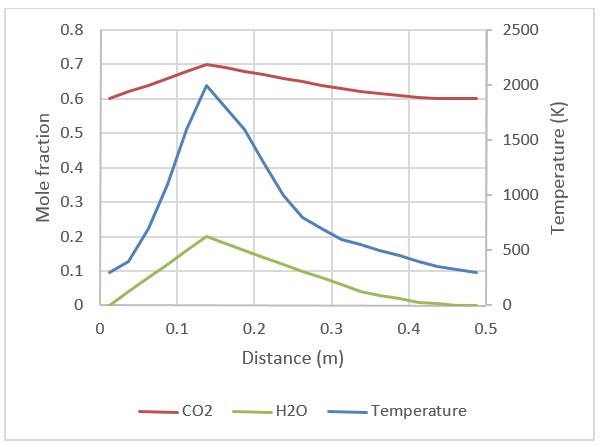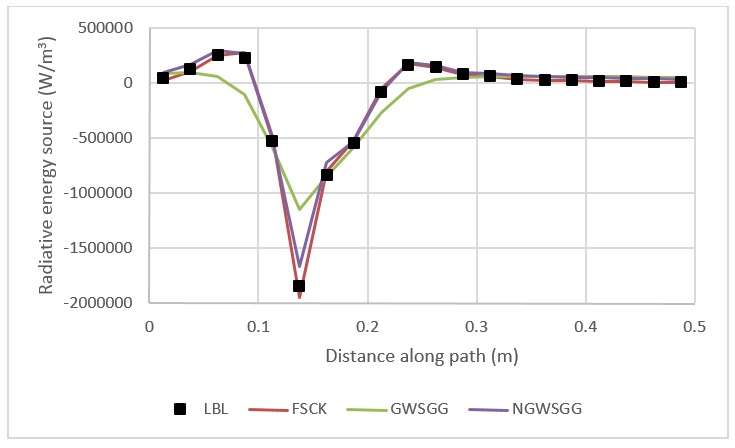-
What radiation models are used for oxy-fuel combustion?
Date posted:
-
-
Post Author
dev@edge.studio
1. Background
Accurate radiation modelling is necessary for predictions of overall thermal efficiency, production rates and pollutant emissions from combustion processes. [GLOSS]Oxy-coal[/GLOSS] or [GLOSS]oxy-fuel[/GLOSS] combustion necessarily has elevated concentrations of radiatively participating species, most significantly CO2 and H2O, which will increase the sensitivity of gas temperatures and heat flux predictions to the treatment of the spectral variation in radiative transfer. Furthermore, the influence of different [GLOSS]flue gas recycle[/GLOSS] schemes on the concentrations of these species, and therefore its influence on radiative transfer, must be taken into account.
The transport of thermal radiation is modelled using the radiation transfer equation (RTE):
Where η denotes a quantity that varies across the electromagnetic spectrum, Iη (r,s) is the spectral radiative intensity at position in direction, s, Ibη is the [GLOSS]Planck function[/GLOSS] and κη, ση and φη are respectively the spectral [GLOSS]absorption coefficient[/GLOSS], [GLOSS]scattering coefficient[/GLOSS] and [GLOSS]scattering phase function[/GLOSS] of the medium. Quantities of interest, such as surface heat flux and radiative impacts on gas temperatures, arise from spectral integrations of all values of η. Methods to solve the RTE can be found in CF65, and the focus of this document is on the applicability of models to approximate the spectral integration applicable to oxy-fuel combustion.
The variation of κη makes integration across the electromagnetic spectrum difficult, as this value oscillates over small spectral intervals, requiring multiple solutions to the [GLOSS]RTE[/GLOSS] for an accurate representation of the intensity field. Approximate models are necessary for the spectral variation of κη as the direct approach, the line-by-line (LBL) method, requires over 105 solutions to the RTE. Different approaches to model the spectral variation of the gas absorption is shown graphically in Figure 1. This document puts forward the suitability of approximate global methods, which represent a grey or reordered absorption coefficient, for calculating radiative transfer in an oxy-fuel combustion medium. This file is only concerned with the gaseous combustion medium, however under solid fuel combustion, particulates will also participate significantly in radiative absorption, emission and scattering, and will also be important in the evaluation of heat transfer under oxy-fuel conditions, just as this phenomenon is important under conventional firing conditions. 
2. Spectral radiation models
Several models have been previously developed in the literature for approximating the spectral integration required. These models include the [GLOSS]Weighted Sum of Grey Gases[/GLOSS] ([GLOSS]WSGG[/GLOSS]) model [1], which uses an empirical relation to approximate gas emissivity from the contribution of fictitious grey gasses, as well as the Spectral Line-based WSGG ([GLOSS]SLW[/GLOSS]) [2], Absorption Distribution Function ([GLOSS]ADF[/GLOSS]) [3] and Full-Spectrum Correlated K ([GLOSS]FSCK[/GLOSS]) [4] models, which all rearrange κη into a form that is easily integrated.
The main drawback to the WSGG model is that its empirical fitting ties the model to specific combustion conditions, however recent model parameters have been published specifically for oxy-fuel conditions. The other global methods assume a consistent relationship between the absorption coefficients at different thermodynamic states, and must be validated before they can be confidently applied to oxy-fuel combustion conditions.
The computational burden of applying spectral radiation models arises from the number of RTE solutions that are required. For the grey WSGG ([GLOSS]GWSGG[/GLOSS]) formulation, this amounts to a single evaluation, however the non-grey WSGG ([GLOSS]NGWSGG[/GLOSS]) and the FSCK method will both typically require five solutions [5].
3. Validation
The GWSGG and NGWSGG , using the oxy-fuel parameters of Kangwanpongpan et al. [6], and the FSCK method were validated against the 1D benchmark oxy-fuel case from Chu et al. [7], which defines a profile of H2O, CO2 and temperature across a 0.5 m path, shown graphically in Figure 2. The benchmark solution was calculated using the [GLOSS]HITEMP2010[/GLOSS] spectral database [8]. The FSCK method in this example was implemented using the narrow band databases from Cai and Modest [9].

The results for the model predictions of the radiation energy source term are shown in Figure 3. The results show that the non-grey methods achieve much higher accuracy than the grey method, leading to the conclusion that accurate treatment of the oxy-fuel combustion environment requires a non-grey radiation model. Grey methods should be avoided for predicting heat transfer under oxy-fuel conditions.

Figure 3: Radiation energy source term predictions from different radiation models
Sources
[1] Hottel and Sarofim, Radiative Transfer, McGraw-Hill, 1967
[2] Denison and Webb, The spectral line-based weighted-sum-of-gray-gases model in nonisothermal nonhomogeneous media, Journal of Heat Transfer, American Society of Mechanical Engineers, 1995
[3] Pierrot, Rivière, Soufiani and Taine, A fictitious-gas-based absorption distribution function global model for radiative transfer in hot gases, Journal of Quantitative Spectroscopy and Radiative Transfer, 1999
[4] Modest and Zhang, he Full-Spectrum Correlated-k Distribution for Thermal Radiation From Molecular Gas-Particulate Mixtures, Journal of Heat Transfer, ASME, 2002
[6] Kangwanpongpan, França, da Silva, Schneider and Krautz, New correlations for the weighted-sum-of-gray-gases model in oxy-fuel conditions based on HITEMP 2010 database, International Journal of Heat and Mass Transfer, 2012
[7] Chu, Liu and Zhou, Calculations of gas thermal radiation transfer in one-dimensional planar enclosure using LBL and SNB models, International Journal of Heat and Mass Transfer, 2011
[8] Rothman, Gordon, Barber, Dothe, Gamache, Goldman, Perevalov, Tashkun and Tennyson, HITEMP, the high-temperature molecular spectroscopic database, Journal of Quantitative Spectroscopy and Radiative Transfer, 2010
[9] Cai and Modest, Improved full-spectrum k-distribution implementation for inhomogeneous media using a narrow-band database, Journal of Quantitative Spectroscopy and Radiative Transfer, 2014
Acknowledgements
RELCOM; Reliable and Efficient Combustion of Oxygen/Coal/Recycled Flue Gas Mixtures – a project undertaken with the financial support of the European Commission under FP7 Grant Agreement Number 268191.
